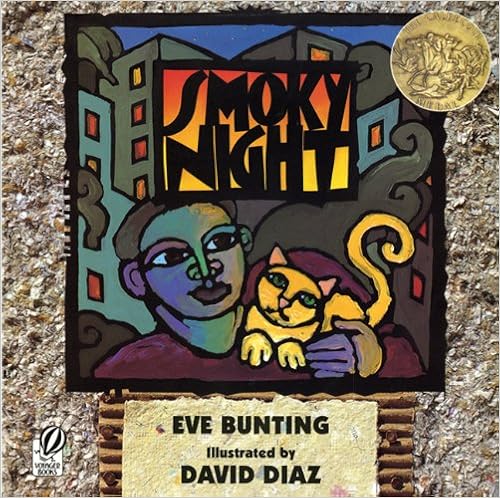Bunting, Eve. Smoky Night. Turtleback Books, 1999.
Lexile Level: 530L
Book Review
Smoky
Night
by Eve Bunting is a beautifully written and illustrated book that
tackles a very difficult and sensitive issue in a sensitive and
compelling way. Set during the Los Angeles riots in 1992, Bunting's
book tells the story of a young boy named Daniel who witnesses the
racially charged rioting that occurred as a result of increasing
unrest that was finally unleashed following the announcements of the
verdicts in the Rodney King trial. Daniel goes to bed assuming that
the riots had ended peacefully, only to be awoken in the middle of
the night to find that his apartment building his been lit ablaze
during the chaos. Daniel does not want to leave, however, as he is
unable to locate his cat, thus the search for Daniel's cat in the
middle of the riots becomes the core story of the book. Bunting does
a wonderful job of demonstrating the severity of the riots as a
whole, but also of giving the reader a window into how the riots
impacted those involved on an individual level. Smoky
Night
is an excellent way to introduce a sensitive, difficult topic like
the Los Angeles riots to children, allowing them to learn how serious
and chaotic they were, without weighing them down with the heavy,
graphic details of the event.
Learning Activity
The
setting of this story is rooted in racial differences and
inequalities. Daniel asks several questions to his mother about the
riots and about how he should interact with others of his race versus
those of another. I want to focus this activity on exploring the
students interact with others that are different in a myriad number
of different ways, yet are still friends and colleagues with those
they are different from. After reading Smoky
Night,
I would have the students pair up and ask each other a handful of
questions about their partner. Questions could include, but are not
limited to, where is your family from?, how do you celebrate certain
holidays?, etc..., in an effort to learn about their colleagues.
They would then present their findings to the rest of the class.
Learning Standards
CCSS.ELA-LITERACY.RL.3.6
Distinguish their own point of view from that of the narrator or those of the characters.
Distinguish their own point of view from that of the narrator or those of the characters.
Goal
The goal of this
exercise is to help the students see that, although their friends and
colleagues may have different backgrounds, beliefs, and ideals, they
are all worthy of acceptance and inclusion.
Objective
Students will ask a
partner questions about their background and home life, in an effort
to learn more about their partners, then present what they learned to
the class.

No comments:
Post a Comment